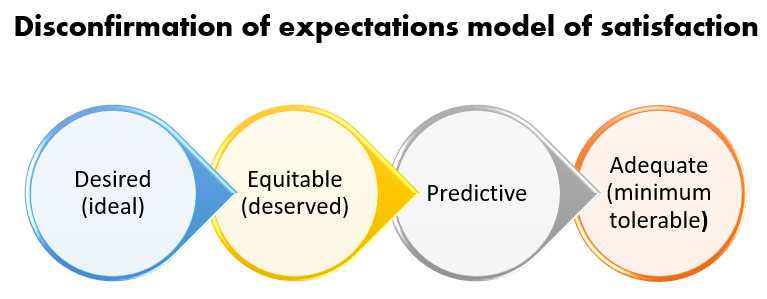Researchers have found there is a relationship between the degree of satisfaction achieved, and the level of customer retention or loyalty. Merely achieving customer satisfaction, however, is not enough.
Benefits of satisfying customers
There are many other benefits of satisfying or delighting customers. Among them are:
- Encourages repeat patronage and loyalty
- Enhances/promotes positive word of mouth
- Lowers cost of attracting new customers
- Reduces failure costs
- Can create sustainable advantages
- Insulates customers from competitors
Disconfirmation of expectations model of satisfaction
- Other influences on satisfaction evaluations (prior attitudes, attribution theory, equity theory)
- Types of expectations
- Desired (ideal)
- Equitable (deserved)
- Predictive
- Adequate (minimum tolerable)
- Managing customer expectations and the zone of indifference
Type of expectations to measure for a research topic
- The four types of expectations are explained early in the chapter. To demonstrate the point students should give an example from their own experience where their expectations differ depending on whether they are considering’ could’ (ideal), ‘would’ (predictive) or’ should’ (equitable or deserved) expectations.
- Concerning the tourism authority, the answer may well depend on whether you want to simply understand visitor expectations or are going to use the results to model customer satisfaction or service quality. If the former then understanding visitors desired or equitable expectations makes most sense – i.e., you are gauging what they feel they want, or desire as opposed to what they think will happen.
- This would then allow new facilities, attractions, service levels etc. to be designed to meet customers’ ideal standards rather than simply satisfying by meeting minimum tolerable (what will happen) expectations.
- Most past satisfaction research has tended to focus on measuring predictive expectations while service quality research has used ideal expectations. But this is not to say that more valid and reliable results would not be obtained by using different expectation measures.
Example: Managing customer expectations of a service firm
Most organizations tend to focus on improving performance but ignore the fact that managing customer expectations is also an important element in the satisfaction process (recall the disconfirmation of expectation model). But what might happen if expectations are lowered too far or raised too high (then the promise may not be able to be kept, and it sets a new benchmark for future purchase occasions which customers will expect the firm to meet).


